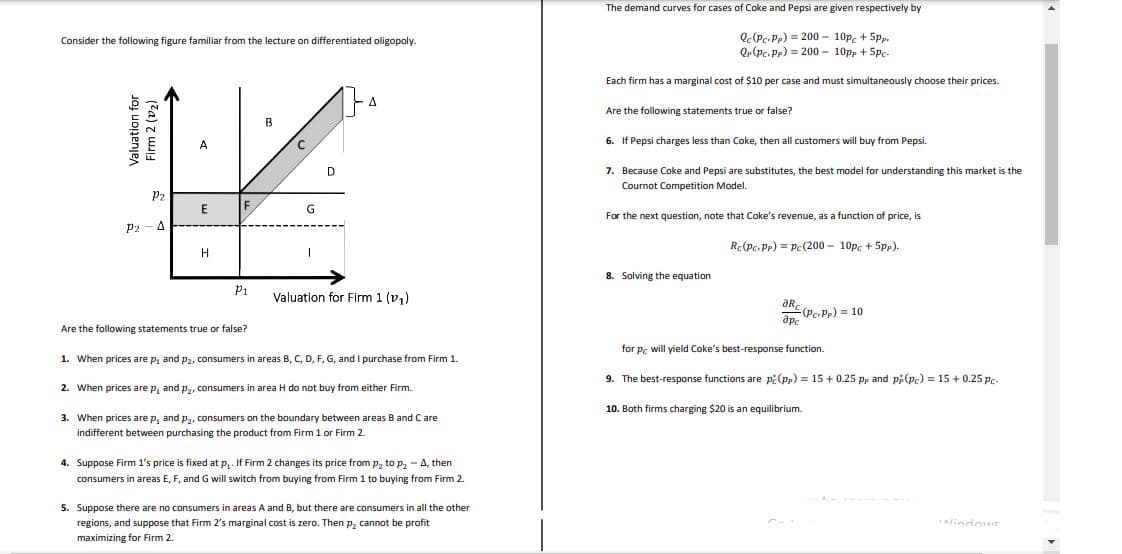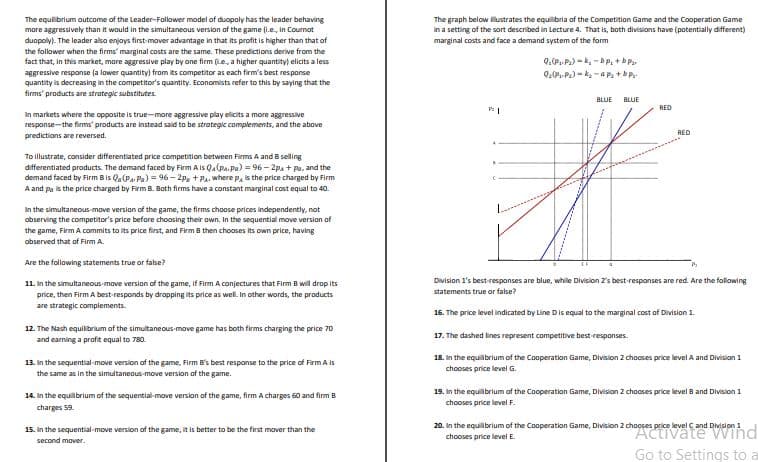The demand curves for cases of Coke and Pepsi are given respectively by Qc(Pc- Pp) = 200 – 10p. + 5pp. Q-(Pc. Pp) = 200 – 10p, + 5pc- Each firm has a marginal cost of $10 per case and must simultaneously choose their prices. Are the following statements true or false? 6. If Pepsi charges less than Coke, then all customers will buy from Pepsi. 7. Because Coke and Pepsi are substitutes, the best model for understanding this market is the Cournot Competition Model. For the next question, note that Coke's revenue, as a function of price, is Re(Pc. Pe) = Pc(200 – 10pc + 5pe). 8. Solving the equation ƏRE (PePe) = 10 apc for pc will yield Coke's best-response function. 9. The best-response functions are pe(pp) = 15 + 0.25 pp and pi(pc) = 15 + 0.25 pc- 10. Both firms charging $20 is an equilibrium.
The demand curves for cases of Coke and Pepsi are given respectively by Qc(Pc- Pp) = 200 – 10p. + 5pp. Q-(Pc. Pp) = 200 – 10p, + 5pc- Each firm has a marginal cost of $10 per case and must simultaneously choose their prices. Are the following statements true or false? 6. If Pepsi charges less than Coke, then all customers will buy from Pepsi. 7. Because Coke and Pepsi are substitutes, the best model for understanding this market is the Cournot Competition Model. For the next question, note that Coke's revenue, as a function of price, is Re(Pc. Pe) = Pc(200 – 10pc + 5pe). 8. Solving the equation ƏRE (PePe) = 10 apc for pc will yield Coke's best-response function. 9. The best-response functions are pe(pp) = 15 + 0.25 pp and pi(pc) = 15 + 0.25 pc- 10. Both firms charging $20 is an equilibrium.
Survey of Economics (MindTap Course List)
9th Edition
ISBN:9781305260948
Author:Irvin B. Tucker
Publisher:Irvin B. Tucker
Chapter9: Monopolistic Competition And Oligoply
Section: Chapter Questions
Problem 20SQ
Related questions
Question
part 10 11 12

Transcribed Image Text:The demand curves for cases of Coke and Pepsi are given respectively by
Q.(Pc.Pe) = 200 - 10p. + 5pp.
Qp(pc. Pp) = 200 - 10pp + 5pc.
Consider the following figure familiar from the lecture on differentiated oligopoly.
Each firm has a marginal cost of $10 per case and must simultaneously choose their prices.
Are the following statements true or false?
B
A
6. If Pepsi charges less than Coke, then all customers will buy from Pepsi.
D
7. Because Coke and Pepsi are substitutes, the best model for understanding this market is the
Cournot Competition Model.
P2
F
For the next question, note that Coke's revenue, as a function of price, is
p2 - A
Rc(Pc.Pp) = Pc (200 - 10pc + 5pp).
H
8. Solving the equation
P1
Valuation for Firm 1 (v,)
OkE (PePr) = 10
Are the following statements true or false?
for pc will yield Coke's best-response function.
1. When prices are p, and p2, consumers in areas B, C, D, F, G, and I purchase from Firm 1.
9. The best-response functions are pi(pp) = 15 + 0.25 pp and pi(pc) = 15 + 0.25 pc.
2. When prices are p, and p, consumers in area H do not buy from either Firm.
10. Both firms charging $20 is an equilibrium.
3. When prices are p, and p2, consumers on the boundary between areas B and Care
indifferent between purchasing the product from Firm 1 or Firm 2.
4. Suppose Firm
s price is fixed at p, If Firm 2 changes its price from p, to p2 - 4 t
consumers in areas E, F, and G will switch from buying from Firm 1 to buying from Firm 2.
5. Suppose there are no consumers in areas A and B, but there are consumers in all the other
regions, and suppose that Firm 2's marginal cost is zero. Then p, cannot be profit
lindows
maximizing for Firm 2.
Valuation for
Firm 2 (vz)

Transcribed Image Text:The equilibrium outcome of the Leader-Follower model of duopoly has the leader behaving
more aggressively than it would in the simultaneous version of the game (i.e., in Coumat
duopoly)- The leader also enjoys first-mover advantage in that its profit is higher than that of
the follower when the firms' marginal costs are the same. These predictions derive from the
fact that, in this market, mare aggressive play by one firm (ie, a higher quantity) elicits a less
aggressive response (a lower quantity) from its competitor as each firm's best response
quantity is decreasing in the competitor's quantity. Economists refer to this by saying that the
firms' products are strategic substitutes.
The graph below lustrates the equilibria of the Competition Game and the Cooperation Game
in a setting of the sort described in Lecture 4. That is, both divisions have (potentially different)
marginal costs and face a demand system of the form
Q.(P-P) -k -b P. +b P
BLUE
BLUE
RED
In markets where the opposite is true-more aggressive play elicits a more aggressive
response-the firms' products are instead said to be strateglc complements, and the above
RED
predictions are reversed.
To illustrate, consider differentiated price competition between Fims A and B selling
differentiated products. The demand faced by Firm A is Qa (Pa. Pa) = 96 – 2pa + Pa, and the
demand faced by Firm Bis Qa(Pa Pa) = 96 – 2p, + Pa, where p, is the price charged by Firm
A and pa is the price charged by Firm B. Both firms have a constant marginal cost equal to 40.
In the simultaneous-move version of the game, the firms choose prices independently, not
observing the competitor's price before choosing their own. In the sequential move version of
the game, Firm A commits to its price first, and Firm B then chooses its own price, having
observed that of Firm A.
Are the following statements true or false?
Division 1's best-responses are blue, while Division 2's best-responses are red. Are the following
11. in the simultaneous-move version of the game, if Firm A conjectures that Firm B will drop its
price, then Firm A best-responds by dropping its price as well. In other words, the products
statements true or false?
are strategic complements.
16. The price level indicated by Line Dis equal to the marginal cost of Division 1.
12. The Nash equilibrium of the simultaneous-move game has both firms charging the price 70
17. The dashed lines represent competitive best-responses.
and eaming a profit equal to 780.
18. In the equilibrium of the Cooperation Game, Division 2 choses price level A and Divisian 1
13. In the sequential-move version of the game, Firm B's best response to the price of Firm A is
the same as in the simultaneous-move version of the game.
chooses price level G.
14. In the equilbrium of the sequential-move version af the game, firm A charges 60 and firm B
charges 59.
19. In the equilibrium of the Cooperation Game, Division 2 chooses price level B and Division 1
chooses price level F.
20. In the equilibrium of the Cooperation Game, Division 2 chooses price level Cand Division 1
"Activate Wihd
Go to Settings to a
15. In the sequential-move version of the game, it is better to be the first mover than the
chooses price level E
second mover.
Expert Solution
This question has been solved!
Explore an expertly crafted, step-by-step solution for a thorough understanding of key concepts.
This is a popular solution!
Trending now
This is a popular solution!
Step by step
Solved in 2 steps

Knowledge Booster
Learn more about
Need a deep-dive on the concept behind this application? Look no further. Learn more about this topic, economics and related others by exploring similar questions and additional content below.Recommended textbooks for you

Survey of Economics (MindTap Course List)
Economics
ISBN:
9781305260948
Author:
Irvin B. Tucker
Publisher:
Cengage Learning



Survey of Economics (MindTap Course List)
Economics
ISBN:
9781305260948
Author:
Irvin B. Tucker
Publisher:
Cengage Learning




Managerial Economics: Applications, Strategies an…
Economics
ISBN:
9781305506381
Author:
James R. McGuigan, R. Charles Moyer, Frederick H.deB. Harris
Publisher:
Cengage Learning

Economics (MindTap Course List)
Economics
ISBN:
9781337617383
Author:
Roger A. Arnold
Publisher:
Cengage Learning